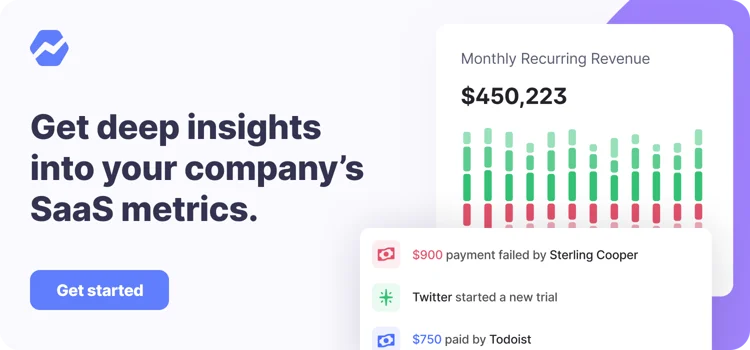Table of Contents

Value metrics influence how much you charge customers for your SaaS product or subscription service.
These metrics determine whether users consider your product or service a good value for the money. When you track these metrics, you can increase or decrease your prices (or pricing tiers) based on customers’ perceived value.
Track SaaS metrics with Baremetrics, the No.1 data-driven dashboard for subscription-based startups and medium-sized businesses worldwide. Start your free trial now.
What are Value Metrics?
Value metrics are a group of metrics that influence the price of your SaaS product or subscription service. These metrics reveal customers’ perceived value of your product or service.
For instance, say you charge users $10 per month for your subscription service. Value metrics provide insights into whether users perceive this monthly cost as a good value for the money.
These metrics tell you if:
- Customers think your product/service is good value for money.
- Customers think your product/service is bad value for money.
- Customers think your product/service is neither good value nor bad value
Read more:11 SaaS Metrics to Measure (and Improve) for Growth
Why You Need to Measure Value Metrics for SaaS Optimization
Value metrics provide you with unparalleled intelligence about how customers perceive the value of your product or service. Use these metrics to prevent the risks associated with overpricing and underpricing.
For instance, some users don’t feel they receive enough value from your most expensive pricing tier. These users might downgrade their subscription to the tier below because they can’t justify the cost. Downgraded users still receive some value from your subscription service.
These users haven’t canceled their subscriptions. But downgrades still affect overall revenue. Using these metrics identifies downgrades and other issues associated with customers’ perceived value.
Many SaaS and subscription companies don’t bother with value metrics, focusing on other KPIs instead like customer acquisition and conversion rate. But these metrics prove lucrative for data-driven companies that want to reduce downgrades, cancelations, and overall churn.
Did you know Baremetrics tracks downgraded customers and SaaS pricing with enhanced functionality?
You can access the right metrics from a centralized dashboard that generates real-time insights into SaaS business and subscription pricing models. Begin your 14-day free trial today.
be honest
How well do you know your business?
Get deep insights into MRR, churn, LTV and more to grow your business
Types of Value Metrics on Baremetrics
They measure the value exchange between your customers and your services – basically, how much your customers pay for what they get.
Most SaaS and subscription companies use the following key performance indicators to measure customers’ perceived value:
Churn
You can measure churn via two separate metrics:
- Customer churn: The percentage of customers you lose every subscription cycle.
- Revenue churn: The percentage of revenue you lose every subscription cycle.
High customer churn and revenue churn indicate customers perceive your product or service as too expensive or not a good value.
Revenue churn also reveals the percentage of revenue lost from downgraded customers, which suggests customers perceive higher-priced subscription tiers as less valuable.
Contraction MRR
It is the monthly recurring revenue (MRR) you lose from customers. Use contraction MRR to identify MRR lost from downgrades, which indicates customers negatively perceive higher-cost tiers.
Average Revenue Per User
Average Revenue Per User tells you the average revenue generated from each customer. Use this metric to identify revenue lost from downgraded customers, which indicates users consider higher-cost tiers not worth the cost.
Read more:5 SaaS Analytics Tools to Track and Grow Your Business
Which Value Metrics Should You Use?
Using all the above metrics proves useful because you can:
- Track customers’ perceived value of products/services over time.
- Prioritize downgraded customers and improve customer retention.
- Measure customers’ perceived value of specific pricing tiers and features.
- Identify opportunities to increase perceived value.
- Prevent downgrades, cancelations, and churn.
- Meet customers’ needs.
- Maintain (or even increase) your number of users, subscription revenue, and cash flow. Boost your balance sheet.
Read more:SaaS Dashboards: How to Measure and Track Growth
Bottom Line
Perceived value is the bedrock of any subscription-based model. Overpriced and underpriced SaaS products and subscription services on your pricing page have enormous ramifications for your entire business.
Value metrics tell you if customers think your product or service is a good value for the money. By tracking these metrics, you can optimize subscription pricing models and prevent downgrades and cancelations.
Baremetrics has a broad range of insightful value metrics for SaaS companies like yours, including churn metrics, contraction MRR, per-user pricing, customer lifetime value (CLV), and ARPU.
Access these metrics from one digital dashboard for accurate real-time insights 24 hours a day. Start your free Baremetrics trial today!



